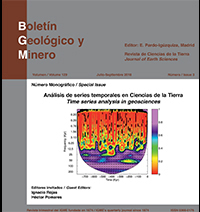Estimación de series de evapotranspiración mediante modelos de lluvia-escorrentía optimizados
DOI:
https://doi.org/10.21701/bolgeomin.129.3.001Palabras clave:
calibrado, evapotranspiración, series temporales a largo plazo, optimización, modelo SACSMAResumen
Se han utilizado series temporales, considerablemente largas, de precipitación y temperatura para el modelado de procesos de precipitación-escorrentía. Las series temporales también se han utilizado para una evaluación precisa de la demanda por evapotranspiración en la cuenca del río Elba en Chequia. Las fluctuaciones temporales de la cubierta de vegetación se han tomado como una indicación de variaciones en la evapotranspiración. La intención es evaluar dichas series temporales complejas como un proceso a largo plazo. El software, recientemente actualizado, del modelo conceptual SAC-SMA, tiene la ventaja de permitir una fácil simulación y reúne las condiciones para el calibrado automático de dicho modelo. Esta herramienta permite una simulación independiente de cada intervalo de tiempo parcial con diversos valores esperados de evapotranspiración. Esto se realiza mediante la identificación consecutiva de parámetros óptimos del modelo. Los valores de evapotranspiración resultante se representan como salidas del modelado. Estos valores serían difíciles de obtener de observaciones meteorológicas, ya sean valores medidos o calculados.
Descargas
Citas
Beer, J. 2005. Solar variability and climate change. Memorie-Società Astronomica Italiana, 76 (4), 751.
Brown, T. 1997. Clearances and clearings: deforestation in Mesolithic/Neolithic Britain. Oxford Journal of Archaeology, 16 (2), 133-146. https://doi.org/10.1111/1468-0092.00030
Buchtele, J. and Koskova, R. 2008. Approaches to credible identification of reliable parameters in rainfall-runoff model from long time series. HydroPredict'2008, Prague, 241-244.
Buchtele, J. and Tesar, M. 2013. Influence of the vegetation cover development at the water regime from surface and groundwater storages. Water Managment, 8, 34-39.
Burnash, R. and Ferral, R. 1973. A generalized streamflow simulation system. Conceptual modeling for digital computers. National Weather Service, 134 pp.
Gilli, M. 2004. An Introduction to Optimization Heuristics. In: Department of Econometrics, University of Geneva and FAME, Seminar University of Cyprus.
Hurst, H.E. 1951. Long-term storage capacity of reservoirs. Transactions of the American Society of Civil Engineers, 116 (2), 770-799. https://doi.org/10.1061/TACEAT.0006518
Hyndman, R. J., and Koehler, A. B. 2006. Another look at measures of forecast accuracy. International Journal of Forecasting, 22 (4), 679-688. https://doi.org/10.1016/j.ijforecast.2006.03.001
Chlumecky, M. 2013. Optimizing of parameters in model (SAC-SMA). POSTER 2013 - 17th International Student Conference on Electrical Engineering. Prague, 1-6
Jewitt, G.P.W., Garratt, J.A., Calder, I.R. 2004. Water resources planning and modelling tools for the assessment of land use change in the Luvuvhu Catchment. Physics and Chemistry of the Earth, 29 (15), 1233-1241. https://doi.org/10.1016/j.pce.2004.09.020
Koren, V. I., Finnerty, B. D., Schaake, J. C., Smith, M. B., Seo, D. J. and Duan, Q. Y. 1999. Scale dependencies of hydrologic models to spatial variability of precipitation. Journal of Hydrology, 217 (3), 285-302. https://doi.org/10.1016/S0022-1694(98)00231-5
Kuczera, G. 1997. Efficient subspace probabilistic parameter optimization for catchment models. Water Resources Research, 33, 177-185. https://doi.org/10.1029/96WR02671
Kundzewicz, Z.W. 2007. Prediction in ungauged basins - a systemic perspective. Predictions in ungauged basins, Brasilia, 309, 38-47.
Kunkel, R. and Wendland, F. 2002. The GROWA98 model for water balance analysis in large river basins - the river Elbe case study. Journal of Hydrology, 259, 152-162 https://doi.org/10.1016/S0022-1694(01)00579-0
Leprieur, C., Kerr, Y.H., Mastorchio, S. 2000. Monitoring vegetation cover across semi-arid regions: comparison of remote observations from various scales. International Journal of Remote Sensing, 21(2), 281-300. https://doi.org/10.1080/014311600210830
Merz, R., Blöschl, G., Parajka J. 2006. Regionalization methods in rainfall-runoff modelling using large catchment samples. IAHS publication, 307, 117.
Vicente-Serrano, S. M., Beguería, S. and López-Moreno, J. I. 2010. A multiscalar drought index sensitive to global warming: the standardized precipitation evapotranspiration index. Journal of Climate, 23 (7), 1696-1718 https://doi.org/10.1175/2009JCLI2909.1
Vrugt, J. A., Gupta, H. V., Bastidas, L. A., Bouten, W. and Sorooshian, S. 2003. Effective and efficient algorithm for multiobjective optimization of hydrologic models. Water Resources Research, 39 (8), 1214 https://doi.org/10.1029/2002WR001746
Wagener, T., Wheater, H. S. and Gupta, H. V. 2004. Rainfallrunoff modelling in gauged and ungauged catchments. Imperial College Press, London, 306pp. https://doi.org/10.1142/9781860945397
Winker, P. and Gilli, M. 2004. Applications of optimization heuristics to estimation and modelling problems. Computational Statistics & Data Analysis, 47 (2), 211-223 https://doi.org/10.1016/j.csda.2003.11.026
Descargas
Publicado
Cómo citar
Número
Sección
Licencia
Derechos de autor 2024 Consejo Superior de Investigaciones Científicas (CSIC)

Esta obra está bajo una licencia internacional Creative Commons Atribución 4.0.
© CSIC. Los originales publicados en las ediciones impresa y electrónica de esta Revista son propiedad del Consejo Superior de Investigaciones Científicas, siendo necesario citar la procedencia en cualquier reproducción parcial o total.
Salvo indicación contraria, todos los contenidos de la edición electrónica se distribuyen bajo una licencia de uso y distribución “Creative Commons Reconocimiento 4.0 Internacional ” (CC BY 4.0). Consulte la versión informativa y el texto legal de la licencia. Esta circunstancia ha de hacerse constar expresamente de esta forma cuando sea necesario.
No se autoriza el depósito en repositorios, páginas web personales o similares de cualquier otra versión distinta a la publicada por el editor.
Datos de los fondos
České Vysoké Učení Technické v Praze
Números de la subvención SGS16/091/OHK3/1T/1















